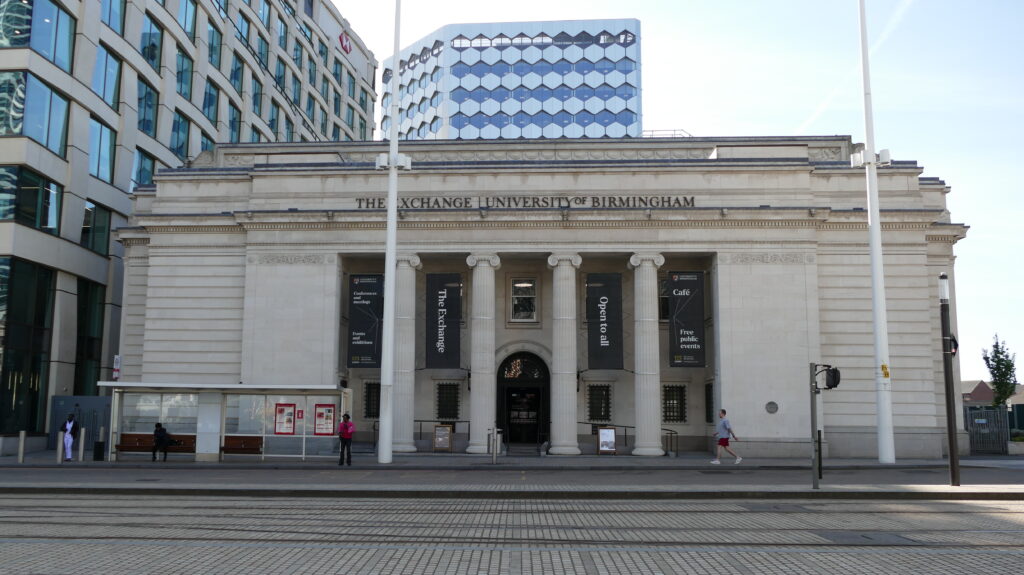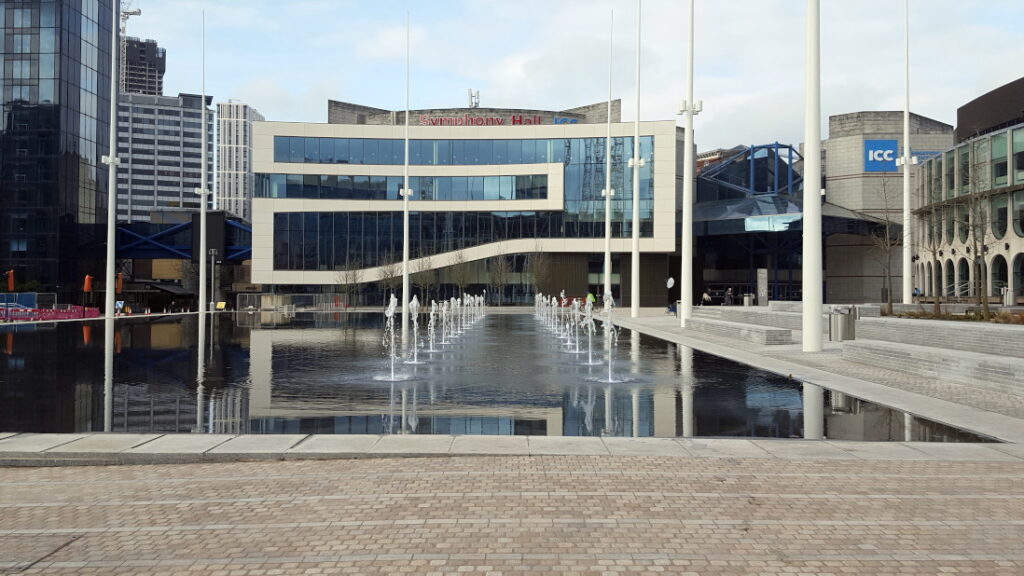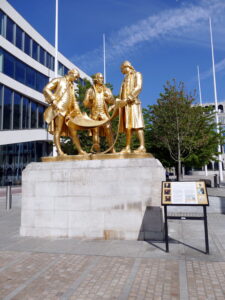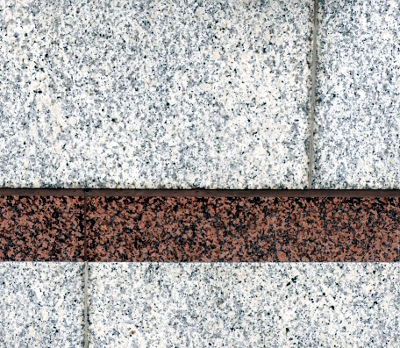Birmingham Building Stones Trails
Trail 2: Centenary Square to Brindleyplace continued
We turn our attention now to the paving and furniture used in the refurbished Centenary Square.
5. Centenary Square
The new-look centenary square (from 2019) now boasts natural stone where previously there was ornamental brickwork. Four varieties of igneous rock have been used in the paving and furniture. They are all from eastern China and are of late Jurassic to Cretaceous age (160-130Ma), associated with major tectonic activity covering a distance of over 4000km, and all are marketed as ‘granites’. The light grey-white stone used for the furniture is a two-mica granite, in keeping with the foundations of the older buildings seen so far. This is known in the trade as ‘Caesar White’ and comes from Shandong Province, to the north of Shanghai. The red-coloured stone is used as paving setts around the Square, with larger slabs around Baskerville House giving a better chance to see the structure and texture of this stone. It formed as an extrusive lava deposit, and many of the stones show evidence of flow-banding. Marketed as ‘New Shiraz’, it comes from Fujian Province, several hundred kilometres south of Shanghai. Also from Fujian province is the buff-yellow stone, providing colourful contrasting setts. The black ‘granite’ (more likely an extrusive igneous rock) is used to line the central water feature, and this comes from Hebei Province, the northernmost source of the four stone types used in the Square.
Turn towards the colonnaded building on the south side of the Square, and cross Broad Street to have a closer look.

The Exchange – University of Birmingham (originally the Birmingham Municipal Savings Bank)
Like the Hall of Memory and Baskerville House, this imposing building is built from Portland Whitbed stone. It was originally the Birmingham Municipal Savings Bank, opened in 1933 and also designed by T. Cecil Howitt, who went on to build Baskerville House. The building was acquired by the University of Birmingham in 2016, and after refurbishment opened as ‘The Exchange’ in September 2021. Once again we see the theme of Portland Stone and Cornish Granite being used here. This building has that impenetrable look of a bank, with few windows and weighty, rusticated masonry. The portico is supported by Ionic columns and the windows on the ground floor are heavily barred. Good examples of oyster shell lags can be observed in the columns and also weathering out on the ashlar masonry. The foundations of the bank are in a brownish Cornish Granite. The two micas can be seen, with the muscovite more obvious on sunny days. Very roughly aligned, brick-shaped ‘small megacrysts’ of feldspar are set in a matrix rich in smoky, brown quartz. Granites with these textures were obtained from the Carnmenellis and Bodmin Plutons of the Cornubian Batholith.

Symphony Hall with new frontage

‘The Golden Boys’
Walk towards the Golden Boys Statue at the west end of Centenary Square, and the impressive new frontage of Symphony Hall. This new development has extended Symphony Hall with a grand new foyer, replacing the former granite façade with extensive use of plate glass.
7. ‘The Golden Boys’
This gilded sculpture of engineers Matthew Boulton, James Watt and William Murdoch is by William Bloye and Raymond Forbes-Kings. Originally installed in 1956, the statue was restored and re-gilded in 2006 then stored for five years during redevelopment of Centenary Square and installed in its new location in April 2022. The plinth is of Portland Whitbed, as described above for the Hall of Memory. Fragments of large oyster shells can be seen weathering out of the oolitic limestone matrix.
Walk to the corner of Symphony Hall then along Broad Street, and stop to look at the façade of the original Symphony Hall building.
8. Symphony Hall
Built in the post-modern style it is part of a complex which includes the International Convention Centre and the Hyatt Regency Hotel. It was designed under a consortium by Percy Thomas Partnership and Renton Wood Howard Levin. It was built between 1987 and 1991 and was not met with universal approval. Foster (2007) describes it as ‘architecturally a huge disappointment’; nevertheless it has fulfilled its use and many of the facilities are designed to a high specification. The new (2021) foyer and façade was designed by architects Page\Park following a competition, and has given Symphony Hall a face-lift and new facilities. The use of glass and concrete has deprived the Centenary Square frontage of its former granite cladding, but there is still plenty of natural stone to see along the Broad Street façade. As was very much the trend at the time, the original building is clad with granite, predominantly white with a red stone used for bands and for columns on the Broad Street façade.

Symphony Hall; grey Sardinian Granite and red Balmoral Granite.
The red granite is from Finland and is distinctive and instantly recognisable. It is called Balmoral Granite and it comes from Kurpi Quarry and others, near Turku in Vehmaa, SW Finland. Composed of bright red feldspar and smoky quartz, biotite and hornblende, this stone is one of the so-called rapakivi granites, a variety called pyterlite. It is an ancient stone too, over 1.5 billion years old. Industrial-scale quarrying began on the Vehmaa peninsula in 1903 and the granite is still actively quarried today and remains very popular as an ornamental stone.
Cross over Broad Street to the complex of buildings around Regency Wharf.
 9. Sculpture: Inner Spirit
9. Sculpture: Inner Spirit
This public artwork is installed in a walkway to Regency Wharf, between the Regency Hyatt Hotel and Wetherspoon’s pub. Entitled ‘Inner Spirit’ it is by sculptor Amanda Brisbane and was erected in 2001. The sculpture is composed of a column of blue glass roundels, flanked by monolithic slabs of Welsh Heather Slate. The slabs of stone are fresh from the quarry and have not been further worked following extraction. They have naturally broken along the cleavage and joint planes which form planar surfaces. The joint surfaces are distinguished by the fine, feather-like ridges on their surfaces and this sculpture will have interest to structural geologists. This feature is indeed known as plumose structure and forms as joints propagate through a rock. The direction of propagation goes in the direction of the feather, from its origin at the base of the ‘feather’ until we run out of rock to fracture at the tip of the ‘feather’. On the large slab of Inner Spirit, joint propagation is from top to bottom as indicated by the arrow on the photograph (left).
The variety of slate used here is dark purple in colour and is the variety known as ‘Heather Slate’. It has numerous small, pale grey-green reduction spots. This makes this instantly recognisable as slate derived from the Cambrian Slate Belt of North Wales which runs SW-NE from Nantlle, through Llanberis to Bethesda. The slate is Lower Cambrian in age and has been metamorphosed to greenschist facies, during which it was subjected to homogeneous strain which developed a strong cleavage. This has made this stone world-famous as a roofing slate. The colour is imparted by iron and titanium oxides and reduced forms of iron oxides in the spots. The only active quarry producing this slate is Penrhyn near Bethesda and this is therefore the likely origin of this stone. The quarry has been in production since the 13th Century and is currently operated by Welsh Slate.
Next door to Inner Spirit is a rather drab-looking building, housing the local branch of the public house chain Wetherspoon’s.
10. Wetherspoon’s: The Soloman Cutler

The Soloman Cutler, ‘schollen’ inclusion in Verde Candeias.
The socle of this building is also of geological interest. It is a metamorphic rock, Verde Candeias, a green gneiss-migmatite. This is the oldest rock we will encounter on this walk, being 2.75 billion years old. It is quarried from the Campo Belo Metamorphic Complex in Minas Gerais, Brazil, part of the São Francisco Craton. These rocks are orthogneisses derived from 3 billion year old protoliths. The major minerals are quartz, plagioclase and pyroxene and the green colour is imparted by chlorite and epidote. For a better view of this stone, walk along Broad Street past Wetherspoons, turn left and walk a short way along Regency Wharf. This face of the building shows Verde Candeias in all its glory. The prominent black inclusions are ‘schollen’ rafts. These are patches of the migmatite melt (the palaeosome) which remain intact and float as ‘rafts’ as the rest of the melt (the neosome) continues to evolve during the process of metamorphism. (These are not to be confused with ‘xenoliths’ which are intact chunks of original or ‘country’ rock which have fallen into the magma but have retained their identity.)
Cross over the road, and walk on to the Celebrity Restaurant.
11. Celebrity Restaurant
The doorway of this Indian Restaurant is the main point of geological interest here. Like many of the buildings in this area, this is brick built. However there is a grand Victorian entrance in dressed stone. The small columns are Peterhead Granite. These are a little weathered and are losing their high polish, however the medium-grained mosaic of grey quartz and pink feldspar, with flecks of biotite is obvious when looking closely. Also look out for the rounded enclaves of a fine-grained, more mafic igneous rock, which are characteristic of this stone. Peterhead is a Caledonian, post-tectonic granite, intruded at 406Ma. It is quarried on the coast, North of Aberdeen and was one of the most popular decorative stones of the Victorian era.A buff-coloured, Carboniferous sandstone is used for the dressings around the doorway, the foundations and the delicate carving in the arch. The stone is cross-bedded and these structures can be seen in the blocks flanking the keystone of the arch. Like the stone used on the plinth of Edward VII, these stones are hard to provenance out of their geological context and without further architectural documentation. It could be Darley Dale Stone or one of the many other sandstones sourced in North Wales, the Midlands or Northern England.
Walk 2 continues on the next page…
References can be found on the last page of the walk (2.3).



